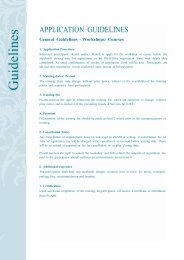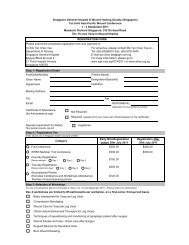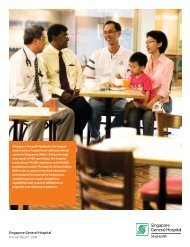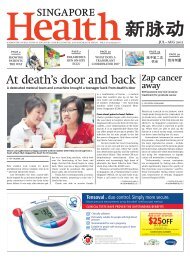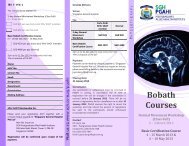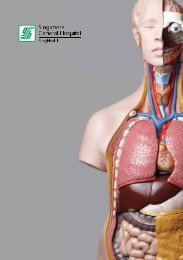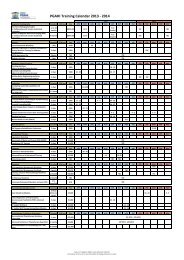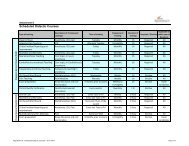Annual Report 2003 - Singapore General Hospital
Annual Report 2003 - Singapore General Hospital
Annual Report 2003 - Singapore General Hospital
Create successful ePaper yourself
Turn your PDF publications into a flip-book with our unique Google optimized e-Paper software.
Prof Tan Ser Kiat<br />
CEO, SGH<br />
<strong>2003</strong> has been a most trying and challenging year in the history of SGH. The painful events<br />
of the year brought the staff together to work cohesively as a team. Together, we weathered<br />
the storm and triumphed, emerging a much stronger team. Our staff has risen to the<br />
challenge well. The lessons learnt were translated into improvements in clinical services<br />
and professional developments.<br />
We will continue to build upon our reputation of clinical excellence. As the flagship medical<br />
institution, SGH will work continuously towards enhancing care through innovations while<br />
managing costs to ensure that our patients have the best care and outcomes. The Campus<br />
is a priceless repository of talent which will help us achieve our vision of a leading academic<br />
medical institution through research, collaboration and training an even better generation<br />
of healthcare professionals.<br />
37<br />
SINGHEALTH ANNUAL REPORT <strong>2003</strong><br />
singapore general hospital<br />
SingHealth<br />
SGH is the largest acute tertiary hospital and<br />
national referral centre in <strong>Singapore</strong>. With 1,400<br />
acute beds and a pool of 500 specialists, it treats<br />
about 60,000 inpatient and 500,000 outpatients<br />
yearly. Through its 26 specialties SGH is also a seat<br />
of medical education and a centre of research for<br />
innovative treatments and medical breakthroughs,<br />
with the ability to capitalise on multi-disciplinary<br />
capabilities and research affiliations to augment<br />
care delivery to patients.<br />
clinical excellence<br />
Pain - the Fifth Vital Sign<br />
Three New Units Opened at SGH<br />
During the year, SGH became the region’s first hospital to include SGH continued to build on its organisational structure to provide<br />
pain as a fifth vital sign, a move to keep pace with international more holistic care to patients during the year. The Department<br />
medical standards and practices. Patients would now be assessed of Behavioural Medicine was established in April <strong>2003</strong> to provide<br />
and monitored for pain in addition to other basic vital signs such a comprehensive integrated multi-disciplinary service to manage<br />
as pulse, blood pressure, core temperature and respiration rate. patients with psychological and psychiatric disorders. Its team of<br />
psychiatrists, psychologists and nurses would support other<br />
More Treatment Options for Patients<br />
clinical departments by helping patients manage conditions<br />
A range of new clinical capabilities and programmes was launched including anxiety, depression, eating disorders, psychosis and<br />
to meet patient needs and to improve service levels. For example, organic brain disorders.<br />
the introduction of endovascular stenting in <strong>2003</strong> provided a<br />
treatment option for arterial stenoses and aneurysms, and A Surgical Assessment Clinic was also launched during the year<br />
endovenous laser therapy for varicose veins. In addition, the new to provide pre-operation assessment of surgical patients and to<br />
laparoscopic surgery – including laparoscopic hernia repair and prepare and educate them for surgery. The clinic would serve a<br />
laparoscopic cardiomyopathy for reflux disease and achalasia – total of six surgical departments namely Orthopaedic, Hand,<br />
offered a minimally invasive alternative to conventional surgery. Obstetrics & Gynaecology, Otolaryngology, Plastic and Dental<br />
Surgery.<br />
Another minimally invasive procedure was the new mammotome<br />
biopsy service, a vacuum-assisted percutaneous breast biopsy In addition, the Geriatric Medicine Unit was established to provide<br />
procedure using computer image-guidance to aid in removing holistic care for geriatric patients in the hospital. The unit<br />
multiple tissue samples. Patients undergoing breast biopsies introduced a co-management programme with the Orthopaedic<br />
would enjoy minimal pain and scarring and a faster recovery Surgery and Urology departments, where doctors from the unit<br />
time. The new procedure could potentially remove all radiological would provide clinical support in these wards. These efforts<br />
evidence of a breast abnormality, providing a highly-accurate translated into encouraging results, with reduced length of stay<br />
diagnosis without the need for open breast surgery. Other new as well as improvements in clinical outcomes for the patients.<br />
diagnostic investigation procedures including MR Arthrography,<br />
CT Virtual Colonoscopy, Cardiac MRI and CT were made Enhanced Imaging Capabilities<br />
available to patients during the year.<br />
SGH implemented a filmless Image Management System across<br />
its wards and clinics during the year. The system would manage<br />
radiological images and scanned medical records, allowing<br />
SingHealth Milestones FY <strong>2003</strong>
38<br />
SINGHEALTH ANNUAL REPORT <strong>2003</strong><br />
singapore general hospital<br />
Patients undergoing breast biopsies enjoy minimal pain<br />
and scarring, and a faster recovery time with the new<br />
The awards and accolades won by SGH staff are<br />
a testament of their commitment to excellence.<br />
39<br />
SINGHEALTH ANNUAL REPORT <strong>2003</strong><br />
singapore general hospital<br />
Mammotome Biopsy Service.<br />
clinicians to access radiological images electronically throughout<br />
the hospital. It would enhance the care of patients requiring<br />
transfers between SGH and the national specialist centres on<br />
Outram Campus once the system was fully rolled out across the<br />
campus in 2004.<br />
A new Cyclotron Centre was opened to manufacture radioactive<br />
tracers required in Positron Emission Tomography (PET) scanning<br />
at all PET Centres in <strong>Singapore</strong>. The availability of PET imaging<br />
within SGH would certainly enhance the advancements in<br />
Oncology, Neurology and Cardiology, in particular on cancer<br />
treatment and molecular imaging in <strong>Singapore</strong> as well as the<br />
region.<br />
Cutting-Edge Research Investigations<br />
Doctors from the Department of Obstetrics & Gynaecology<br />
undertook a research using subtractive hybridisation and realtime<br />
PCR to analyse gene expression profiles in endometriosis.<br />
The team filed a patent entitled ‘Method and Probes for Diagnosing<br />
a Ggynaecological Condition’ with the US Patent and Trademark<br />
Office in September <strong>2003</strong>.<br />
The Department further began a study on establishing and<br />
validating a pre-implantation genetic diagnosis programme in<br />
<strong>Singapore</strong>, which would be used to work up pre-implantation<br />
genetic diagnosis for alpha and beta thalassaemia in couples<br />
where both partners were carriers and desired a normal pregnancy.<br />
The Department of Rheumatology and Immunology received a<br />
five-year BMRC grant to conduct a prospective study to develop<br />
HRQoL measures for clinical trials and cohort studies in <strong>Singapore</strong>.<br />
The Department of <strong>General</strong> Surgery published 33 Medlined<br />
research papers in <strong>2003</strong>, covering a range of both basic and clinical<br />
surgical sciences.<br />
Accolades for SGH<br />
SGH bagged three awards at the ‘Asian <strong>Hospital</strong> Management<br />
Awards <strong>2003</strong>’ in the Human Resource Development, Quality<br />
Medical Care and Customer Service categories respectively. The<br />
hospital also became the first restructured hospital to receive<br />
accreditation from the <strong>Singapore</strong> Workforce Development Agency<br />
as an ‘Approved Assessment Centre’ under the National Skills<br />
Recognition Scheme.<br />
The Department of Pathology scored the rare distinction of being<br />
the largest and most comprehensive complex of laboratories in<br />
<strong>Singapore</strong> to receive accreditation by the College of American<br />
Pathologists. In another achievement, the Dietetics and Nutrition<br />
Services Department became the first in-house kitchen in a<br />
hospital to achieve the Hazard Analysis Critical Control Point<br />
certification in September <strong>2003</strong>.<br />
In recognition of the commendable workplace health promotion<br />
programmes in the hospital, SGH received the <strong>Singapore</strong><br />
H.E.A.L.T.H Award (Silver), and the SHARE Gold Award for<br />
supporting the Community Chest SHARE programme.<br />
QC Team PETS from Ward 76 clinched the NOVA award in <strong>2003</strong><br />
with its winning project on ‘Improvement in the current method<br />
of elevating patient’s leg while sitting out of bed’.<br />
Outstanding Individual Performance<br />
A/Prof Ho Lai Yun (Department of Neonatal & Developmental<br />
Medicine) received the Outstanding Paediatrician for Asia Award<br />
presented by the Association of Paediatric Societies in Southeast<br />
Asia Region.<br />
Dr Ling Ai Ee (Department of Pathology) received the Excellence<br />
Award at the 6th Asia Pacific Congress of Medical Virology for her<br />
outstanding contributions to medical virology.<br />
Dr Goh Yau Hong (Department of Otolaryngology) received the<br />
Enterprising Agency Award at the Enterprising Challenge Award<br />
for his research on developing a disposable diagnostic card to<br />
detect early-stage nasopharyngeal cancer.<br />
Dr Gan Yu Unn and Dr Tay Kiang Hiong (Department of Diagnostic<br />
Radiology) received the Young Radiologist Award and the Best<br />
Paper Award respectively at the 12th <strong>Annual</strong> Scientific Meeting<br />
of the <strong>Singapore</strong> Radiological Society.<br />
Dr Beh Siu Joo (Department of Diagnostic Radiology) received<br />
the Best Paper Award under the Ambulatory Category at the<br />
International Conference on Evidence-based Medicine<br />
incorporating the 10th <strong>Annual</strong> SGH-Stanford University <strong>Hospital</strong><br />
Joint Update <strong>2003</strong>.<br />
Ms Lou Huei-Xin and Ms Andrea Kwa (Pharmacy Department)<br />
received second prizes in the Oral Presentation and Poster<br />
presentation respectively at the Pharmacy Congress. Ms Lou was<br />
also the winner of the Best Paper award at the Society of<br />
Transplantation <strong>Singapore</strong> Meeting.<br />
Ms Koh Lai Heng (Department of Pathology) was conferred the<br />
President’s Social Service Award for Individuals for her long-term<br />
commitment to volunteering.<br />
Mdm Pek Lye Peng (Ward 52A) won the <strong>Singapore</strong> Labour<br />
Foundation Educational Tours Award for Model Workers, in<br />
recognition of her outstanding work performance, exemplary<br />
work conduct and good work attitude.<br />
collaboration<br />
International Research Collaborations<br />
Assoc Prof Xiao Zhi Cheng (Department of Clinical Research) led<br />
a 24-member international research team to discover an<br />
interaction between F3/contactin and Notch1 on the surface of<br />
cells found in the central nervous system. The breakthrough,<br />
which was published in CELL, provided invaluable insights into<br />
the regeneration or repair of the myelin sheath.<br />
In another international project, the Department of<br />
Gastroenterology started a research initiative involving Hong<br />
Kong, China, United Kingdom, Germany and Malaysia. The team<br />
would study the use of MARS for critically ill patients with<br />
treatment of viral liver disease.<br />
Innovative Liver Cancer Treatments<br />
PSiOncology Pte Ltd, a joint venture between SGH and the UKbased<br />
biotechnology company pSiMedica, worked on developing<br />
innovative localised treatments, using nano-structured porous<br />
silicon, for cancers of the liver and other abdominal organs in<br />
patients with late stage, inoperable disease. The efficacy of its<br />
lead product, 32-P-Biosilicon TM , was recently demonstrated in preclinical<br />
brachytherapy trials using animal models bearing human<br />
tumours. In its next phase, the collaboration would be conducting<br />
clinical trials on patients with inoperable liver cancer to assess<br />
the safety of the product and to monitor the efficacy of the<br />
implantable radioactive device.
40<br />
SINGHEALTH ANNUAL REPORT <strong>2003</strong><br />
singapore general hospital<br />
The discovery of an interaction between F3/contactin<br />
and Notch1 on the surface of cells found in the central<br />
nervous system - a breakthrough which provided<br />
invaluable insights into the regeneration or repair of<br />
the myelin sheath.<br />
The introduction of the E-<br />
physiotherapy service enables patients<br />
to undergo rehabilitation from the<br />
comfort of their own home, while the<br />
Surgical Assessment Clinic provides<br />
pre-operation assessment which<br />
prepares and educates patients for<br />
their surgery.<br />
41<br />
SINGHEALTH ANNUAL REPORT <strong>2003</strong><br />
singapore general hospital<br />
Local Research Collaborations<br />
The Department of Endocrinology collaborated with the<br />
Dermatology Unit to investigate the prevalence of chronic urticaria<br />
and other cutaneous manifestation of Graves’ Disease. The aim<br />
was to identify patients with Graves’ Disease who were at risk of<br />
cutaneous manifestation by detecting a special group of antibodies<br />
directed against the receptors on mast cells.<br />
The Department of Urology designed and developed a robotic<br />
prostate biopsy device, in collaboration with the National Cancer<br />
Centre and Nanyang Technological University. The device would<br />
be undergoing clinical trial to assess its accuracy and reproducibility<br />
in biopsy needle delivery to a pre-determined intra-prostatic area.<br />
The Speech Therapy department participated in a multi-centre,<br />
longitudinal study in the management of clefts and secondary<br />
palate.<br />
Clinical Trials<br />
The Department of Experimental Surgery implemented 35 research<br />
projects, with six contracted and collaborative projects in preclinical<br />
trial evaluation of drugs and devices conducted with the<br />
local and overseas industry. The Associate for Accreditation and<br />
Assessment of Animal Care conducted a preliminary evaluation<br />
of the department’s programmes and facilities during the year, as<br />
part of the department’s plan to achieve international standards<br />
and accreditation.<br />
In addition, the Department of Gastroenterology was involved in<br />
various clinical trials on treatment-resistant chronic hepatitis B,<br />
using various new nucleoside analogues.<br />
Advanced Training for Healthcare Professionals<br />
The Postgraduate Allied Health Institute was set up in July <strong>2003</strong>,<br />
offering 350 training places in 50 professional development courses<br />
and clinical attachment programmes. These courses provided a<br />
formalised framework in the development of advanced<br />
professional skills and competencies for allied health staff.<br />
Despite disruptions caused by the SARS outbreak, the Postgraduate<br />
Medical Institute conducted six Continuing Medical Education<br />
programmes for more than 500 general practitioners during the<br />
year. It also collaborated with the <strong>Singapore</strong> Medical Association<br />
to hold seven CME series seminars on medical ethics and health<br />
law.<br />
Knowledge Sharing with Overseas Students<br />
By offering various scholarships, the Postgraduate Medical Institute<br />
attracted 43 foreign doctors from 14 countries to undertake<br />
postgraduate training. The Associate Dean’s Office also accepted<br />
45 overseas elective students for attachment at SGH during the<br />
year.<br />
The Institute of Advanced Nursing also had an active year,<br />
collaborating with the Ministry of Foreign Affairs to conduct the<br />
Nursing Management course for participants from 14 countries.<br />
The Learning Centre organised hospital management training<br />
and study visit programmes for more than 110 healthcare<br />
professionals from China, Thailand and Australia.<br />
Public Education for the Community<br />
In an ongoing public health education programme, doctors, nurses<br />
and allied health professionals from SGH gave about 80 talks at<br />
public forums or health fairs organised by the hospital or in their turn to enrol in the STEP programme at Margaret Drive<br />
collaboration with community organisations.<br />
Special School. The speech therapy would provide early<br />
intervention, helping these children develop their communicative<br />
Support for <strong>Singapore</strong>’s Healthcare Aspirations<br />
ability during their two-year wait for admission to the school.<br />
As the largest player in the public healthcare sector, SGH set the<br />
example by introducing corresponding initiatives to respond to Physiotherapy by Internet<br />
the Ministry of Health’s eight healthcare priorities unveiled by E-physiotherapy was a new service introduced for the benefit and<br />
Acting Minister for Health, Mr Khaw Boon Wan in August <strong>2003</strong> convenience of patients who were unable to travel to the hospital<br />
(see chart below).<br />
for treatment due to physical limitations or lack of time. It allowed<br />
commitment<br />
New Programmes to Boost Patient Care<br />
The year saw the introduction of a Renal Health Management<br />
Programme to streamline and coordinate the care of patients<br />
with chronic kidney disease or chronic renal failure. The<br />
programme allowed for continued care between the primary<br />
healthcare team at the polyclinics and the hospital-based<br />
nephrological service at SGH.<br />
SGH also introduced Speech Therapy and Occupational Therapy<br />
for children with Autism Spectrum Disorder while they waited<br />
Ministry of Health Priorities<br />
SGH Initiatives<br />
for physiotherapy sessions to be conducted over the internet<br />
while patients underwent rehabilitation at home. The new service<br />
provided continuing care for patients recovering from stroke,<br />
traumatic head injuries, Parkinson’s Disease and other neurological<br />
conditions. It was an especially viable service option during the<br />
SARS outbreak, during which patients stayed away from hospitals.<br />
Active Case - Coordinating Roles for Nurses<br />
The nurse case-coordinator assumed a more active role in<br />
discharge planning and health education under a new Ward-<br />
Based Case Management System. He or she would focus solely<br />
on supervising patient care, paving the way for establishing a<br />
stronger rapport between the nursing staff and the patients and<br />
• Build a healthy population<br />
• Healthy Lifestyle programme<br />
• Manage diseases<br />
• Disease Management Programmes, SGH Homecare services<br />
• Exploit information technology<br />
• SMS reminders, e-prescriptions, e-Menu, e-physiotherapy<br />
• Manage healthcare inflation<br />
• Savings through GPO, “Cut Waste” theme<br />
• Ensure healthcare financing through 3 Ms • Cost-effective pricing strategies<br />
• Exploit economic value as regional hub • <strong>Hospital</strong> management consultancy, regional business development tie-ups<br />
• Counter disease outbreak<br />
• Safeguard medical standards<br />
• Epidemiological & Surveillance unit<br />
• Evaluate over-servicing (drugs/investigations) and prolonged stay
42<br />
SINGHEALTH ANNUAL REPORT <strong>2003</strong><br />
singapore general hospital<br />
43<br />
SINGHEALTH ANNUAL REPORT <strong>2003</strong><br />
singapore general hospital<br />
The Inpatient Pulmonary Rehabilitation Programme<br />
helps patients with chronic lung problems to achieve<br />
and maintain maximum level of independence.<br />
SGH became the region’s first hospital to<br />
include pain as a fifth vital sign.<br />
their relatives. Just one nurse case-coordinator would now be<br />
able to provide relatives with advice on the patient’s condition<br />
and assistance in discharge planning and placement in stepdown<br />
facilities.<br />
The nurse case-coordinator would also be making on-line referrals<br />
to the community hospitals and nursing homes under a new<br />
Discharge Planning Programme. This programme incorporated<br />
two new IT systems – the Community Healthcare Management<br />
System and the Integrated Care Internet Services – in the wards<br />
to provide prompt information transfer between the hospital<br />
and the step-down facilities, resulting in a smoother transition<br />
for patients and their caregivers.<br />
Foot Screening of Diabetic Patients<br />
Patients at the Diabetes Centre, who were referred by polyclinics,<br />
would now receive a more appropriate level of care with the<br />
introduction of protocol-led pathways. These pathways included<br />
routine foot screening and patient education by the podiatrist<br />
during the patient’s first visit to the centre to allow for the<br />
detection of early foot problems.<br />
Support for Burn Patients<br />
A Burns Support Group was formed to provide pyschological<br />
and social support to burns survivors. The group would comprise<br />
burns survivors and hospital staff mainly from the departments<br />
of Plastic Surgery, SGH Burns Centre, Medical Social Services and<br />
the Rehabilitation Centre. A dedicated Medical Social Worker<br />
would also operate an electronic information hot-line dedicated<br />
to meeting the needs of survivors and their family members.<br />
New Cord Blood Bank Under Planning<br />
Plans to set up the <strong>Singapore</strong> Cord Blood Bank gained<br />
momentum during the year driven by SGH’s Department of<br />
Haematology. This first public cord blood bank in <strong>Singapore</strong><br />
would be launched in 2004 under the collaborative efforts of<br />
SingHealth, National Healthcare Group and other partners.<br />
Action against SARS<br />
SGH played a key role in the fight against the SARS virus when<br />
the outbreak affected <strong>Singapore</strong> in March <strong>2003</strong>. A SARS Taskforce<br />
was established immediately to direct hospital-wide efforts to<br />
contain the infection adopting the ‘protect, detect and isolate’<br />
strategy.<br />
Through internal and public communication channels within<br />
the hospital, SGH stressed the importance of personal hygiene,<br />
safety and precautionary measures in the fight against the deadly<br />
virus. Staff were issued with personal protective equipment, and<br />
mandatory temperature taking became a part of the daily routine.<br />
The hospital also implemented stringent infection control<br />
measures. All ICU units in the hospital were renovated with<br />
negative-pressure isolation rooms and high-efficient particulate<br />
filters, while isolation wards were created to admit patients<br />
suspected of the infection. While visitors were screened, the twovisitors<br />
per patient policy was strictly enforced and contact tracing<br />
performed when necessary. Departments such as the Medical<br />
Social Services and Behavioural Medicine were also active in<br />
providing support in the form of counselling and debriefing for<br />
staff during the height of the crisis.<br />
The Department of Internal Medicine played an instrumental role<br />
during the outbreak when it admitted the first laboratoryassociated<br />
case of SARS. The early recognition and isolation of<br />
the patient within an hour of his arrival in the ward helped in<br />
preventing a recurring outbreak in <strong>Singapore</strong>. The Pathology<br />
Department was also active in diagnosing the SARS virus during<br />
the crisis as the department’s Virology section was appointed a<br />
World Health Organisation Collaborating Laboratory for the<br />
diagnosis of the SARS virus. The newly built Biosafety Level 3<br />
laboratory, equipped with the latest diagnostic technology for<br />
the safe diagnosis and typing of dangerous microorganisms, was<br />
fully utilised and contributed significantly to the diagnostic efforts<br />
during the crisis.<br />
Sadly, the hospital lost two staff members in the fight against<br />
SARS. Dr Alexandre Chao from the Department of <strong>General</strong> Surgery<br />
and Mdm Kiew Miyaw Tan from the Urology Centre succumbed<br />
to the disease on 22 April and 25 April respectively.<br />
SGH<br />
Size<br />
Bed Complement (as at end Mar)<br />
Beds in Service<br />
Workload<br />
Bed Occupancy Rate<br />
Inpatient Admissions<br />
Inpatient Discharges<br />
Total Patient Days<br />
Average Length of Stay (days)<br />
Total Surgical Operations<br />
Day Surgeries<br />
Inpatient Surgeries<br />
SOC Attendances<br />
A&E Attendances<br />
Staffing (Average Monthly)<br />
Total<br />
Doctors<br />
Nurses<br />
Allied Healthcare Professionals<br />
Others<br />
FY <strong>2003</strong><br />
1,545<br />
1,407<br />
70.7%<br />
56,529<br />
57,027<br />
364,388<br />
6.4<br />
59,418<br />
32,472<br />
26,946<br />
479,855<br />
105,459<br />
5,053<br />
503<br />
1,948<br />
827<br />
1,776<br />
FY 2002<br />
1,501<br />
1,386<br />
79.7%<br />
68,126<br />
68,224<br />
403,261<br />
5.9<br />
71,604<br />
37,100<br />
34,504<br />
567,986<br />
116,918<br />
4,953<br />
469<br />
1,905<br />
802<br />
1,776


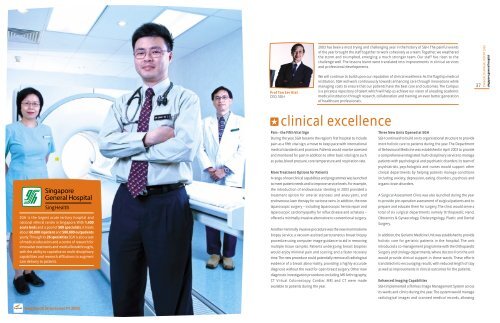
![help document [pdf]](https://img.yumpu.com/26291587/1/190x245/help-document-pdf.jpg?quality=85)
